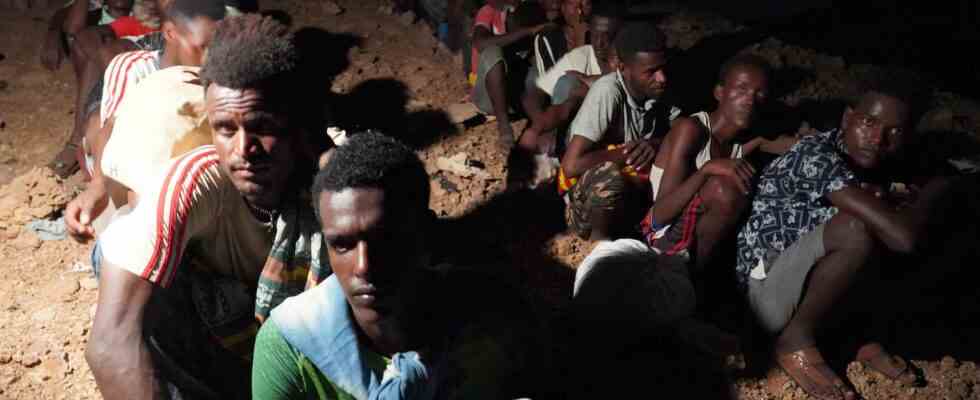world mirror
Status: 11/29/2022 7:03 am
It is a movement of refugees that is hardly noticed by the world public: from East Africa across the sea to the Arabian Peninsula. Tens of thousands dare the crossing every year – and get from one theater of war to the next.
The smuggler’s message reached us in Obock, a small town in northern Djibouti. On the same day, he says, migrants from the steppe behind the city are taken to a boat. The group should be loaded onto a pick-up in the middle of the hinterland.
Many migrants are from Ethiopia, fleeing poverty or the war that has been raging in Tigray province for the past two years. Some come from neighboring countries. So far they have made it, now they should continue with the ship to the Arabian Peninsula.
“There’s work in Saudi Arabia, that’s where I want to go,” says one of the migrants, who is said to be from Sudan. Djibouti turns a blind eye to illegal migrants. However, the smugglers face imprisonment.
Refugees try to reach the Arabian Peninsula via Djibouti
Norbert Hahn, ARD Nairobi, Weltspiegel, November 28, 2022
The number of refugees is increasing
According to the International Organization for Migration (IOM), more than 25,000 people fled from East Africa to the Arabian Peninsula by the middle of the year alone – almost as many as in the entire previous year.
It is one of the major refugee movements that is hardly noticed by the world public.
Translate to war
A few kilometers away, two dozen young men are lined up in two groups on the cliff above the beach, all searching for a better future.
Obock is a dreary small town with about 30,000 inhabitants in the north of Djibouti, on the Horn of Africa. There is hardly any agriculture, no industry, hardly any work. The town is located on the Gulf of Tadjoura, which merges a little further north into the Bab al-Mandab, the “Gate of Tears”: a 27-kilometer-wide strait between Africa and the Arabian Peninsula.
Yemen is on the other side. Many of the young men on the beach don’t know that a war is still waiting there. .
fishing and smuggling
In Obock people live mainly from fishing – and from smuggling: petrol, alcohol, everything. Also people. But smuggling is of course forbidden in Djibouti. That’s why nobody talks about it here.
“You don’t earn much with your work here,” says Fischer Abdou. “You have to leave Djibouti for that. You earn more in Yemen.” It is poverty that turns fishermen into people smugglers – who then sometimes end up in the clutches of the Coast Guard.
The cargo of the small boats consists of refugees who have walked for days through the dry parts of Ethiopia and Djibouti, often without clean water, often without having eaten anything. What they have they wear on their backs, what money they had they mostly had to leave to the smugglers.
In Obock people live mainly from fishing – and from smuggling: petrol, alcohol, everything. People are also transported to Yemen in boats like these.
Image: ARD Nairobi
Many are traumatized
At the base of the International Organization for Migration, IOM for short, those who cannot make it on their own are taken in. 250 people find help here, but many migrants have to be turned away by the helpers.
Some of them, often young people, women or children, have experienced incredible things on their journey. Social worker Hawa Musa works with the children, who can hardly process what they have experienced on their own.
“They speak through images,” says Hawa Musa. “Sometimes they paint reality. They paint the picture of the smuggler lifting the wooden club. They come to us for therapy.” There are two directions: “If they come from Ethiopia, they still have goals. When they come back, they stop smiling and are exhausted.”
Tens of thousands died or disappeared
Samsa is one of those who couldn’t take it anymore. She came from northern Ethiopia, got married and went to Yemen with her husband to look for work. He moved on to Saudi Arabia. She got by with small jobs in Yemen and had to raise her three children alone. Now she’s back in Djibouti and only wants one thing: “I want to go home and take my children to school. I don’t want to go to a foreign country anymore, I’ve had enough of it.”
At least Samsa is safe in the IOM camp. According to the organizations, tens of thousands of migrants have died or disappeared in recent years when they were on various routes to Saudi Arabia, Qatar or the Gulf States.
“War?” – In Yemen?
IOM staff member Khadija Ahmed takes us into the middle of nowhere near a beach that symbolizes a refugee tragedy. Two heaps of stones, a few shells: Nine dead lie here, nameless. An Ethiopian family was wiped out when their tug boat went down in storms and waves. “If we had her address, we would get in touch with her relatives,” says Ahmed.
While the sun is already setting, the last migrants are still on their way. They too were up for days. The food was too expensive, the water along the way was dirty. They talk about their hopes – but do they also know that Yemen is at war? “War?” one of them asks and hesitates. Then he says, visibly frustrated: “Everything is war. There is violence everywhere.”

